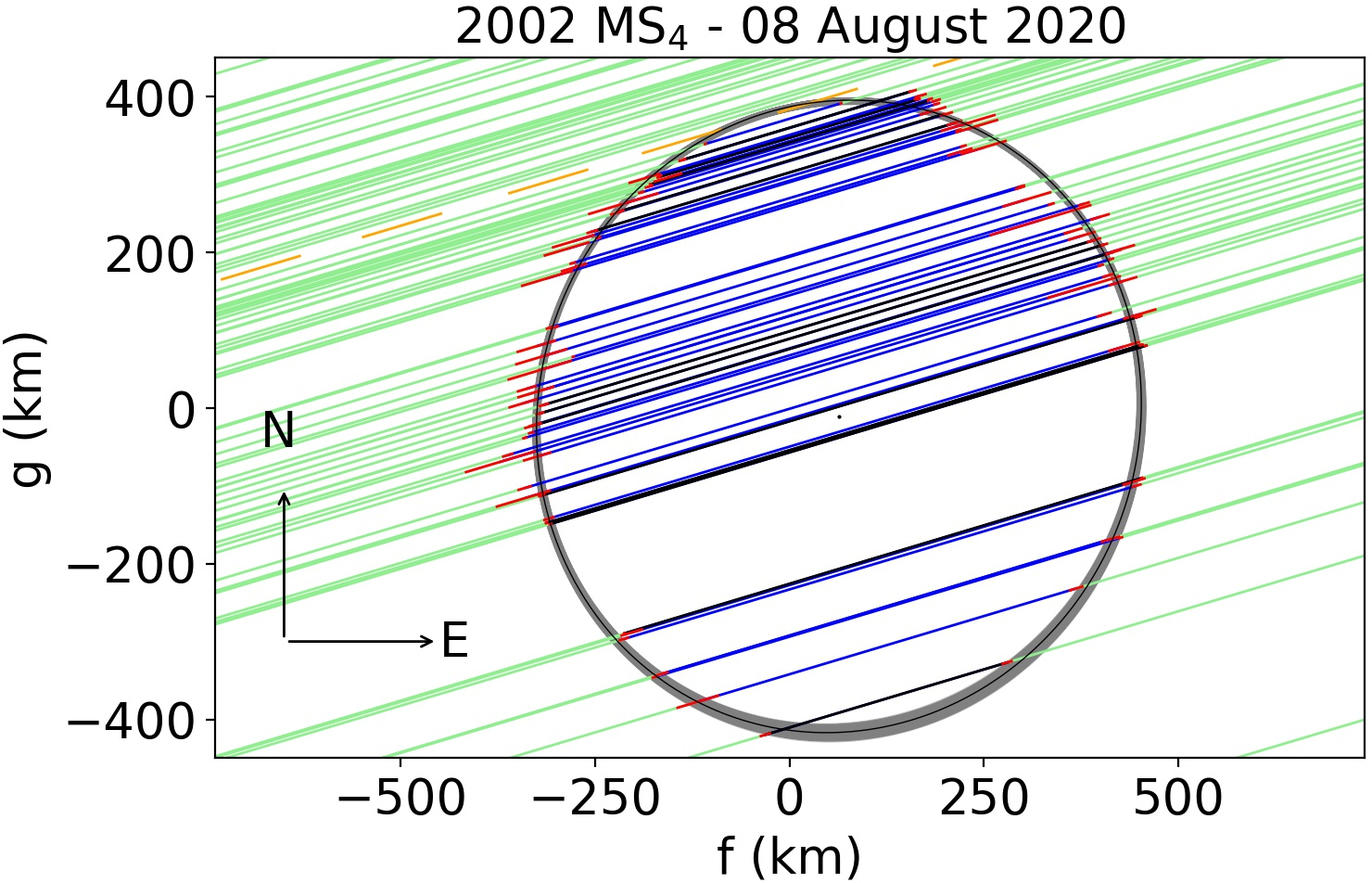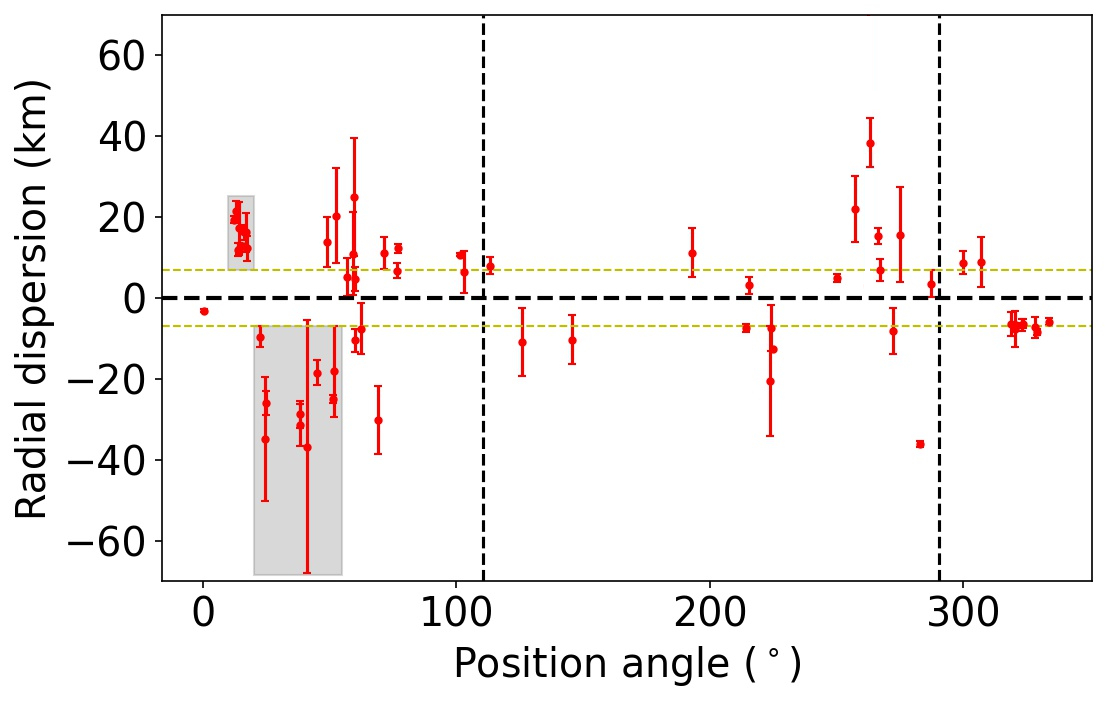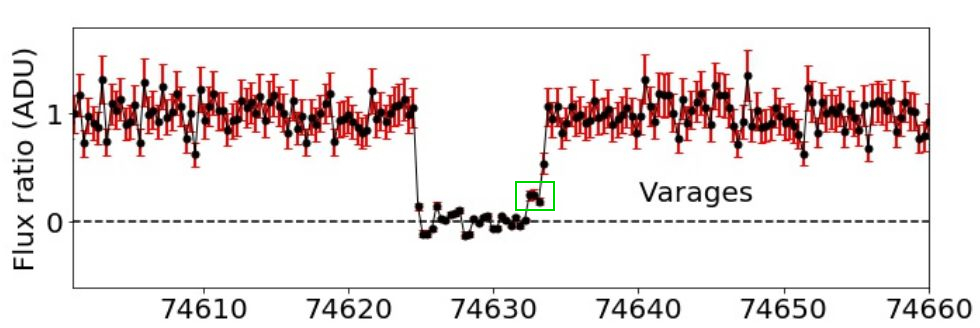Evidence of topographic features on (307261) 2002 MS4 surface
- 1Observatório Nacional/MCTIC, R. General José Cristino 77, Bairro Imperial de São Cristóvão, Rio de Janeiro (RJ), Brazil (flaviarommel@on.br)
- 2Laboratório Interinstitucional de e-Astronomia - LIneA & INCTdo e-Universo, Rua Gal. José Cristino 77, Bairro Imperial de São Cristóvão, Rio de Janeiro (RJ), Brazil.
- 3Federal University of Technology - Paraná (UTFPR/DAFIS), Rua Sete de Setembro, 3165, Curitiba (PR), Brazil.
- 4Instituto de Astrofísica de Andalucía, IAA-CSIC, Glorieta de la Astronomía s/n, 18008 Granada, Spain.
- 5Institut Polytechnique des Sciences Avancées IPSA, 63 boulevard de Brandebourg, F-94200 Ivry-sur-Seine, France.
- 6Institut de Mécanique Céleste et de Calcul des Éphémérides, IMCCE, Observatoire de Paris, PSL Research University, CNRS, Sorbonne Universités, UPMC Univ Paris 06, Univ. Lille, 77, Av. Denfert-Rochereau, F-75014 Paris, France.
- 7LESIA, Observatoire de Paris, Université PSL, CNRS, Sorbonne Université, Univ. Paris Diderot, Sorbonne Paris Cité, 5 place Jules Janssen, 92195 Meudon, France.
- 8UNESP - São Paulo State University, Grupo de Dinâmica Orbital e Planetologia, CEP 12516-410, Guaratinguetá, SP, Brazil.
- 9Florida Space Institute, University of Central Florida, 12354 Research Parkway, Partnership 1, Orlando, FL, USA.
- 10Observatório do Valongo/UFRJ, Ladeira Pedro Antônio 43, Rio de Janeiro (RJ), Brazil.
- 11Akdeniz University, Department of Space Sciences and Technologies, Antalya, Turkey.
- 12TÜBİTAK National Observatory, Akdeniz University Campus, 07058 Antalya, Turkey.
- 13Euraster, 1 rue du tonnelier, 46100 Faycelles, France.
- *A full list of authors appears at the end of the abstract
Trans-Neptunian Objects (TNOs) are small bodies that orbit the Sun with a semi-major axis larger than Neptune's4. They are thought to be remnants of the Solar System primordial disk and can retain information about the early stages of our planetary system's formation. Since the discovery of Albion3 in 1992, thousands of objects were detected in this orbital region, but only the Pluto system13 and (486958) Arrokoth14 has been visited so far by a spacecraft. Detailed topographic studies of Pluto and Charon6,7 presented superficial features of ~6 km while reprocessed Voyager images of Uranus' largest satellite - Oberon, show a mountain11 of ~11 km. Discovered15 in 2002 the big TNO 2002 MS4 is dynamically classified as a hot classical TNO. Thermal measurements made by Spitzer Space Telescope and Herschel Space Observatory, resulted an area equivalent diameter16 of 934 +/- 47 km and a geometric albedo at V-band of 0.051-0.022+0.036.
Stellar occultation is a ground-based method that has been presenting exciting advances in the knowledge of Centaurs' and TNOs' physical properties2,9,10,12 and rings1,8. We predicted and observed seven stellar occultations by 2002 MS4 between 2019 and 2021 under the European Research Council (ERC) Lucky Star project framework. The most successful one involved 116 telescopes from Europe, North Africa, and Western Asia on 8 August 2020.
Here we will present results about 2002 MS4 size, shape and topographic features. Stellar occultation data show an equivalent diameter of about 800 +/- 24 km. On the projected northern hemisphere, they are evidence of topographic features of about 20 km. Following the procedure described by Johnson and McGetchin in 1973, and assuming that 2002 MS4 is mainly composed of ice with densities between 1.0 - 2.0 g/cm3, this object supports surface features of about 7 km. However, if we consider that ice density increases toward the object's centre, then 2002 MS4 can support more prominent features. Figure 1 presents the projected profile detected on the 8 August 2020 stellar occultation.

Figure 1: blue lines are the positive detections with uncertainties in red. Green segments present the surrounding region and in black is the best projected elliptical limb. Shaded region are the solutions inside the 3σ.
Next figure presents the radial dispersion of the observed points from the black ellipse as a position angle function. This angle is measured from the local North and increases toward the East (Figure 1). Shaded rectangles show the evidence of a mountain and a depression of about 20 km between 10 and 55 degrees.

Figure 2: radial dispersion from better elliptical limb as a function of the position angle. Dashed green lines present the 7 km lower limit for global roughness. Shaded regions are evidence of the mountain and the depression.
Additionally, the northernmost grazing light curve at 2002 MS4 acquired from Varages observatory in France presents a direct detection of a minor surface feature. Note that, in figure 3, the star partially appears before the reappearance, probably due to a depression or a local mountain.

Figure 3: normalized star flux as a function of time as seen by Varages observatory. The 3 intermediate points before emersion are inside the green rectangle.
Acknowledgements: F.L.R is thankful for the support of the CAPES scholarship. The following authors acknowledge the respective CNPq grants: F.B-R 309578/2017-5; R.V-M 304544/2017-5, 401903/2016-8; J.I.B.C. 308150/2016-3; M.A 427700/2018-3, 310683/2017-3, 473002/2013-2. This study was financed in part by the Coordenação de Aperfeiçoamento de Pessoal de Nível Superior - Brasil (CAPES) - Finance Code 001 and the National Institute of Science and Technology of the e-Universe project (INCT do e-Universo, CNPq grant 465376/2014-2). G.B-R acknowledges CAPES-FAPERJ/PAPDRJ grant E26/203.173/2016, M.A FAPERJ grant E-26/111.488/2013 and A.R.G-Jr FAPESP grant 2018/11239-8. B.E.M thanks the CAPES/Cofecub-394/2016-05 grant. P.S-S. acknowledges financial support by the Spanish grant AYA-RTI2018-098657-J-I00 "LEO-SBNAF" (MCIU/AEI/FEDER, UE). We would like to acknowledge financial support from the State Agency for Research of the Spanish MCIU through the “Center of Excellence Severo Ochoa” award for the Instituto de Astrofı́sica de Andalucı́a (SEV-2017-0709) and the financial support by the Spanish grant AYA-2017-84637-R. Part of the results were based on observations taken at the 1.6 m telescope on Pico dos Dias Observatory of the National Laboratory of Astrophysics (LNA/Brazil). Part of this work was carried out within the “Lucky Star" umbrella that aggregates the efforts of the Paris, Granada and Rio teams. It is funded by the European Research Council under the European Community’s H2020 (2014-2021/ERC Grant Agreement No. 669416). This work has made use of data from the European Space Agency (ESA) mission Gaia (https://www.cosmos.esa.int/gaia), processed by the Gaia Data Processing and Analysis Consortium (DPAC, https://www.cosmos.esa.int/web/gaia/dpac/consortium). Funding for the DPAC has been provided by national institutions, in particular the institutions participating in the Gaia Multilateral Agreement.
References
1Braga-Ribas, F., Sicardy, B., Ortiz, J. L., et al.: 2014, Nature, 508, 72.
2Dias-Oliveira, A., Sicardy, B., Ortiz, J. L.,et al.: 2017, The Astronomical Journal, 154, 22.
3Jewitt, D., and Luu, J.: 1993, Nature, 362, 730.
4Jewitt, D., Morbidelli, A., and Rauer, H.: 2008, Saas-Fee Advanced Course 35: Trans-Neptunian Objects and Comets.
5Johnson, T. V. and McGetchin, T.R. 1973, Icarus, 18, 612.
6Moore, J. M., McKinnon, W.B., et al.: 2016, Science, 351, 1284.
7Nimmo, F., Umurhan, et al. 2017, Icarus, 287, 12.
8Ortiz, J. L., Santos-Sanz, P., Sicardy, B., et al.: 2017, Nature, 550, 219.
9Ortiz, J.L., Santos-Sanz, P., Sicardy, B., et al.: 2020, Astronomy and Astrophysics, 639, A134.
10Santos-Sanz, P., Ortiz, J. L., Sicardy, B., et al.: 2021, Monthly Notices of the Royal Astronomical Society, 501.
11Schenk, P. M. and Moore, J. M.: 2020, Philosophical Transactions of the Royal Society of London Series, A378.
12Sicardy, B., Ortiz, J. L., Assafin, M., et al.: 2011, Nature, 478, 493.
13Stern, S. A., Bagenal, F., Ennico, K. et al.: 2015, Science, 350, aad1815.
14Stern, S. A., Weaver, H. A., Spencer, J. R., et al.: 2019, Science, 364, aaw9771.
15Trujillo, C. A., Brown, M. E., Minor Planet Electronic Circulars – MPEC 2002-W27.
16Vilenius, E., Kiss, C., Mommert, M., et al.: 2012, Astronomy and Astrophysics, 541, A94.
J. Marques Oliveira (7), A. R. Gomes-Júnior (8), R. Boufleur (2) and 175 co-authors (observers team).
How to cite: Rommel, F. L., Braga-Ribas, F., Vara-Lubiano, M., Ortiz, J. L., Desmars, J., Morgado, B. E., Benedetti-Rossi, G., Sicardy, B., Vieira-Martins, R., Camargo, J. I. B., Santos-Sanz, P., Morales, N., Duffard, R., Fernández-Valenzuela, E., Margoti, G., Assafin, M., Pereira, C. L., Kilic, Y., Frappa, E., and Lecacheux, J. and the co-authors: Evidence of topographic features on (307261) 2002 MS4 surface, European Planetary Science Congress 2021, online, 13–24 Sep 2021, EPSC2021-440, https://doi.org/10.5194/epsc2021-440, 2021.

